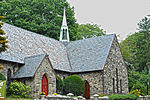History of Briarcliff Manor

The history of Briarcliff Manor, a village in the county of Westchester, New York, can be traced back to the founding of a settlement between the Hudson and Pocantico Rivers in the 19th century. The area now known as Briarcliff Manor had seen human occupation since at least the Archaic period, but significant growth in the settlements that are now incorporated into the village did not occur until the Industrial Revolution. The village, which was incorporated with one square mile in 1902, has expanded primarily through annexation: of Scarborough in 1906 and from the town of Mount Pleasant in 1927.Early leaders of village government include President William de Nyse Nichols from 1902 to 1905, President Walter W. Law, Jr. from 1905 to 1918, President-Mayor Henry H. Law from 1918 until his death in 1936, and Mayor J. Henry Ingham from 1936 to 1941.
Excerpt from the Wikipedia article History of Briarcliff Manor (License: CC BY-SA 3.0, Authors, Images).History of Briarcliff Manor
Holbrook Road,
Geographical coordinates (GPS) Address Nearby Places Show on map
Geographical coordinates (GPS)
| Latitude | Longitude |
|---|---|
| N 41.15 ° | E -73.85 ° |
Address
Holbrook Road 54
10510
New York, United States
Open on Google Maps









